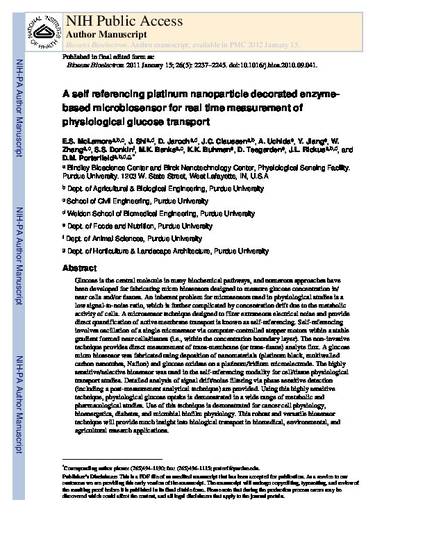
Article
A self referencing platinum nanoparticle decorated enzyme-based microbiosensor for real time measurement of physiological glucose transport
Biosensors and Bioelectronics
(2011)
Abstract
Glucose is the central molecule in many biochemical pathways, and numerous approaches have
been developed for fabricating micro biosensors designed to measure glucose concentration in/
near cells and/or tissues. An inherent problem for microsensors used in physiological studies is a
low signal-to-noise ratio, which is further complicated by concentration drift due to the metabolic
activity of cells. A microsensor technique designed to filter extraneous electrical noise and provide
direct quantification of active membrane transport is known as self-referencing. Self-referencing
involves oscillation of a single microsensor via computer-controlled stepper motors within a stable
gradient formed near cells/tissues (i.e., within the concentration boundary layer). The non-invasive
technique provides direct measurement of trans-membrane (or trans-tissue) analyte flux. A glucose
micro biosensor was fabricated using deposition of nanomaterials (platinum black, multiwalled
carbon nanotubes, Nafion) and glucose oxidase on a platinum/iridium microelectrode. The highly
sensitive/selective biosensor was used in the self-referencing modality for cell/tissue physiological
transport studies. Detailed analysis of signal drift/noise filtering via phase sensitive detection
(including a post-measurement analytical technique) are provided. Using this highly sensitive
technique, physiological glucose uptake is demonstrated in a wide range of metabolic and
pharmacological studies. Use of this technique is demonstrated for cancer cell physiology,
bioenergetics, diabetes, and microbial biofilm physiology. This robust and versatile biosensor
technique will provide much insight into biological transport in biomedical, environmental, and
agricultural research applications.
Keywords
- Glucose flux,
- Self referencing,
- Physiology,
- Biosensor,
- Carbon nanotubes
Disciplines
Publication Date
2011
DOI
10.1016/j.bios.2010.09.041
Publisher Statement
This is a manuscript of an article from Biosensors and Bioelectronics 26 (2011): 2237, doi:10.1016/j.bios.2010.09.041. Posted with permission. Copyright 2011.This manuscript version is made available under the CCBY-NC-NC 4.0 license http://creativecommons.org/licenses/by-nc-nd/4.0/
Citation Information
Eric S. McLamore, J. Shi, D. Jaroch, Jonathan C. Claussen, et al.. "A self referencing platinum nanoparticle decorated enzyme-based microbiosensor for real time measurement of physiological glucose transport" Biosensors and Bioelectronics Vol. 26 Iss. 5 (2011) p. 2237 - 2245 Available at: http://works.bepress.com/jonathan_claussen/23/
